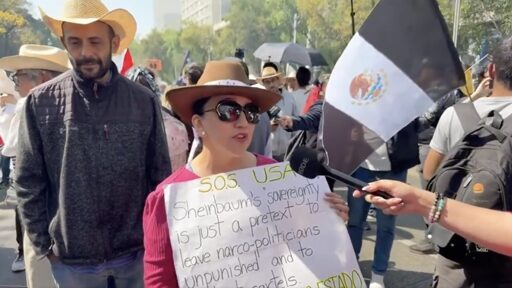Despite the great controversy and public attention generated by the first demonstration by the so-called “Gen Z” on November 15 in the Mexican capital, its second iteration on Thursday, November 20, seems to have diminished in volume.
The press estimated that 17,000 protesters took to the Zócalo on Saturday, while the same media outlets estimated that no more than 200 people attended the second protest days later on Thursday. The police were on alert after the previous clashes, given that protesters sought to emulate the incidents.
However, on this occasion, the clashes were not repeated, despite the huge number of journalists and media outlets ready to record the event, journalists who, at times, seemed to outnumber the protesters, according to CNN.
What Mexican authorities did report was that several protesters had clubs, masks, and chains confiscated, while a small group of hooded individuals entered the Zócalo (the capital’s main square), although no incidents were reported.
A mobilization that failed to achieve its goal
The protesters gathered on the same day as the traditional military parade in honor of the Mexican Revolution, which was led by President Claudia Sheinbaum. Since the first “Gen-Z” protest, the Mexican president’s team has been working to expose the alleged links between the protesters and the interests of private national and international businessmen. Despite fears, the military parade and the opposition mobilization did not clash.
According to Sheinbaum, almost USD 5 million has been invested in promoting and disseminating anti-government sentiment on social media. Among those implicated are Mexican businessmen such as Claudio X González and Ricardo Salinas Pliego (the latter is the owner of TV Azteca and the corporate conglomerate Salinas Group), as well as far-right groups like the NGO Atlas Network.
In addition, the president offered her hypothesis as to why the opposition turnout was so low. According to Sheinbaum, the violence displayed by some groups caused widespread rejection among the majority of protesters on November 15.
She also said that there was an attempt to portray the previous demonstration as if the majority of young people were against the government, to which Sheinbaum responded that the tiny protest on November 20 disproves this type of framing by journalists and influencers who follow a political and partisan agenda.
What role is right-wing PAN playing in the demonstrations?
In fact, it was recently revealed that one of the main drivers of the demonstrations, Edson Saúl Andrade Lemus, is an employee of the right-wing National Action Party (PAN), which is part of the opposition. According to National Congress records, Andrade has worked in the social media administration of three PAN representatives, Daniela Álvarez, Frida Guillén, and Luisa Gutiérrez.
According to Telesur, sources close to the PAN claimed that Andrade was behind the promotion of the demonstrations thanks to the bots he manages, something he has used before to raise the profile of his former bosses in Congress on social media.
In response to these accusations, Jorge Romero Herrera, national leader of the PAN, stated that although Andrade works for his organization, his party has no connection with the call for the November 15 march.
Is a “soft coup” being organized in Mexico?
The president of the National Institute for Political Training of MORENA (the ruling party), Rafael Barajas, warned that the recent demonstrations may be part of a plan to carry out a classic “soft” coup, a formula attributed to American political scientist Gene Sharp. The different stages of the classic “soft” coup include promoting a mood of unrest among the population, accusing the government of violating human rights due to a supposedly “totalitarian” attitude, the intensification of the struggle of opposition movements who demand better political and social conditions, and the turn towards violent street protests.
The next step would consist of “psychological warfare” and “destabilization of the government” so that the president would finally resign.
According to Barajas, this is the script being followed by the promoters of the recent demonstrations: “Many foreigners were surprised by the very violent episode of the November 15 march, which had a great impact among MAGA supporters and which they present as a ‘success,’ as a massive march. The march was exaggerated by the media and announced as the Mexican version of the Nepalese uprising. But it is something totally different and is part of the logic of Trumpism and the Monroe Doctrine. It is part of the logic of ‘soft coups.’”
He also stated that the United States is using a similar strategy against all governments that do not align with its interests. Thus, they are accused of being narco-terrorists or close to drug trafficking groups so that they lose legitimacy and the destabilization of these governments can continue according to the plan explained above.
The truth is that the Mexican government seems to be continuing to closely monitor future demonstrations, which it claims are being financed by shady capital and interests. At the moment, Sheinbaum enjoys an approval rating of almost 70% among the population, something that the recent demonstrations are surely seeking to change.
For now, opposition sectors have not demonstrated organic unity, and if links between the march organizers and right-wing political parties are proven, the “anti-establishment” narrative of Generation Z’s protests could quickly fade in the North American country.
The post Second anti-Sheinbaum protest loses momentum appeared first on Peoples Dispatch.
From Peoples Dispatch via this RSS feed


